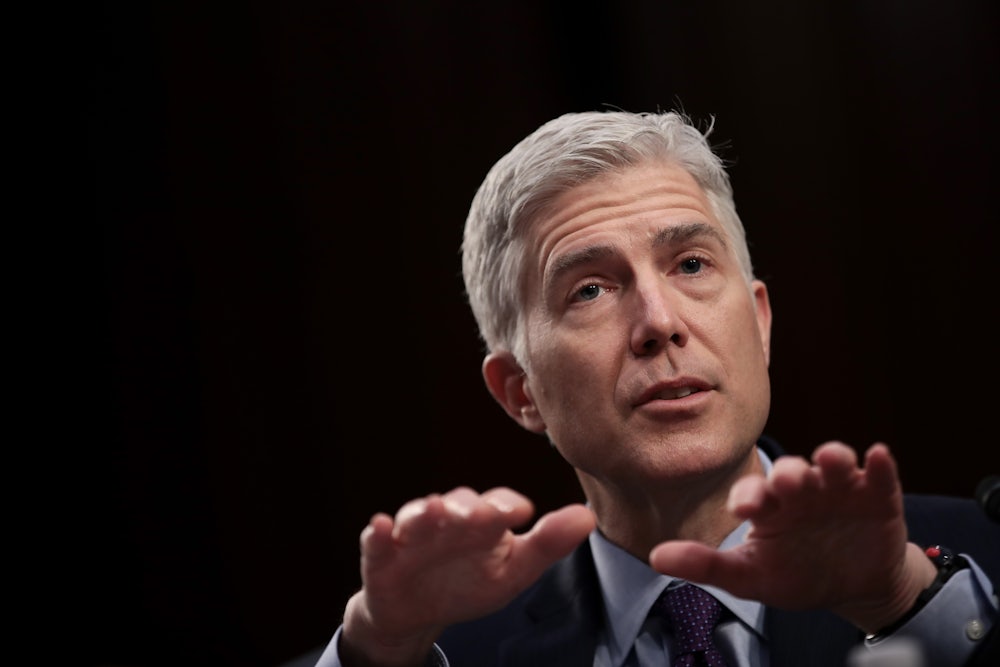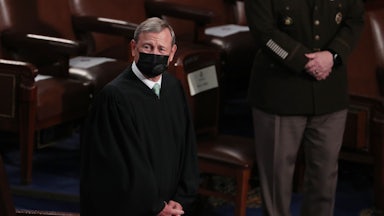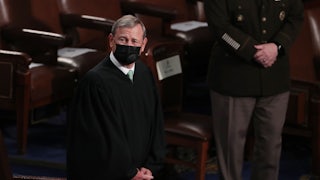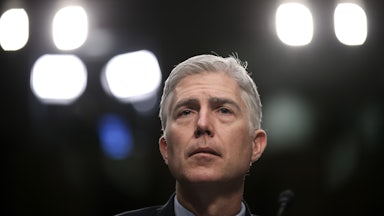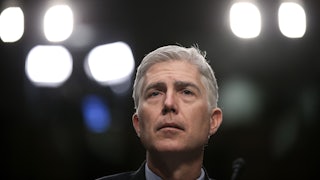The Supreme Court’s decision to block the Occupational Safety and Health Administration from issuing a Covid testing mandate for many U.S. businesses continues to offer a lot to ponder. Even looking beyond the merits of the ruling, it is not as strong an opinion as one might expect for the highest court in the land—perhaps this is to be expected, given that the case was argued, and the opinions drafted, with more haste than usual. Multiple legal scholars have noted, for example, that it spends virtually no time balancing who would be harmed if the court granted the motion to stay the mandate, which is sort of the entire crux of the dispute.
Anita Krishnakumar, a Georgetown University law professor, also noted on a legal blog that both the majority opinion and Justice Neil Gorsuch’s concurring opinion run counter to many of the principles of textualism, the method of reading federal laws that conservatives have championed. In a nutshell, textualism generally means reading the statute as it is written. Among the breaches that Krishnakumar noted: Gorsuch cited congressional inaction over the last two years as evidence of congressional intent when passing the OSHA statute many decades ago; he favorably noted that one chamber of Congress voted on a resolution of disapproval of the mandate, even though it carried no legal weight, and both opinions made no real attempt at a close textual analysis of what the words in the statute actually mean.
“I am not cynical by nature and typically resist partisan, cynical readings of the Court’s statutory cases,” Krishakumar concluded, “but it is hard to view this case as anything other than a sign that at least in high-stakes political cases, the conservative Justices on the modern Roberts Court no longer feel the need to follow a textualist or formalist approach to statutory interpretation even as a pretext to justify reaching their preferred interpretive outcomes.”
To that end, one of the most troubling aspects of the case was the conservative majority’s reliance on what’s known as the “major questions doctrine.” This obscure judicial precept, which has mostly developed over the past two decades, first arose in a series of cases where the court was asked to decide whether federal agencies had exceeded the power given to them by Congress when interpreting federal law. The thrust of the doctrine is relatively simple: If a federal agency wants to do something big, it must have a clear mandate from Congress to do so.
The majority opinion in the OSHA testing-mandate case does not explicitly name the doctrine, though it cites precedents where it came up. It fell to Gorsuch to explain it more outwardly. “Why does the major questions doctrine matter?” he asked. “It ensures that the national government’s power to make the laws that govern us remains where Article I of the Constitution says it belongs—with the people’s elected representatives. If administrative agencies seek to regulate the daily lives and liberties of millions of Americans, the doctrine says, they must at least be able to trace that power to a clear grant of authority from Congress.”
But Gorsuch’s own opinion—and the majority’s, for that matter—suggests that the major questions doctrine is less about Congress’s authority and the virtues of democratic self-government and more about the Supreme Court’s power and the ideological dispositions of some of its members. The court’s conservatives have shown a strong interest in curbing what they call the “administrative state,” a catch-all term they use to describe federal regulatory agencies. And with the doctrine, they appear to have found a tool to diminish the federal government’s power to, well, govern.
The doctrine’s first few appearances at the Supreme Court were more modest than the OSHA decision last week. In a 1994 case, the court ruled that the Federal Communications Commission couldn’t use its power to “modify” tariffs for telecommunications companies to essentially abolish most of the tariffs, concluding that the move would essentially rewrite the Communications Act of 1934, which laid out the tariffs in the first place. And in 2000, the justices concluded that the Food and Drug Administration couldn’t decide to regulate tobacco products for the first time in its history because Congress had implicitly denied it that jurisdiction through other anti-smoking laws.
Another judicial doctrine known as Chevron deference generally requires courts to defer to federal agencies on whether a rule that they draft falls within the scope of what Congress has established in federal law, so long as it is a reasonable interpretation of that law. When the Supreme Court formally established that doctrine in the 1980s, it explained that federal agencies have more policy expertise and are more responsive to democratic forces than the courts. Chevron deference is unpopular with conservative legal scholars, however, for tipping the balance in favor of the agencies when interpreting the scope of their powers.
The major questions doctrine allows the justices to sidestep Chevron deference entirely. Over the past two decades, the court has concluded that it can weigh in on the statute’s meaning if the policy in question is one of “vast” or “deep … economic or political significance.” It’s not exactly clear what falls under that label. Indeed, depending on one’s perspective, it’s unclear what wouldn’t count. Any high-profile or high-stakes rule laid out by a federal agency could conceivably be described as such, especially by those with a stake in the outcome.
Some rules are more obviously significant than others. In 2020, Congress imposed a temporary national moratorium on evictions as part of its efforts to combat the Covid-19 pandemic. After it expired, the Centers for Disease Control and Prevention issued an eviction moratorium of its own under a provision in the Public Health Service Act of 1944, which allows the agency to “provide for such inspection, fumigation, disinfection, sanitation, pest extermination, destruction of animals or articles found to be so infected or contaminated as to be sources of dangerous infection to human beings, and other measures, as in [its] judgment may be necessary.” A group of Alabama landlords challenged the order’s constitutionality in federal court.
When they asked the Supreme Court to block the moratorium last summer, the justices declined to do so in a 5–4 vote. Justice Brett Kavanaugh wrote a concurring opinion that explained he had voted to keep the order intact through its expiration date roughly one month later and would vote to block it next time unless Congress had reauthorized the moratorium itself. The Biden administration, facing pressure from Democratic lawmakers and activists, issued a slightly more limited version of moratorium after the previous one lapsed. As expected and as forewarned, the Supreme Court soon struck down the mandate for exceeding the CDC’s statutory powers.
The court grounded its decision in a fairly straightforward textualist reading of the statute in question, which did not mention evictions or housing and instead focused on goods and livestock traveling across state borders. “This downstream connection between eviction and the interstate spread of disease is markedly different from the direct targeting of disease that characterizes the measures identified in the statute,” the court argued. “Reading both sentences together, rather than the first in isolation, it is a stretch to maintain that §361(a) gives the CDC the authority to impose this eviction moratorium.”
It did not stop there, however, fleshing out a more expansive reason for blocking the moratorium. “Even if the text were ambiguous, the sheer scope of the CDC’s claimed authority under §361(a) would counsel against the Government’s interpretation,” it added, quoting from a line of cases on the major questions doctrine. “We expect Congress to speak clearly when authorizing an agency to exercise powers of ‘vast economic and political significance.’ That is exactly the kind of power that the CDC claims here.”
The second-to-last sentence there—the “we expect Congress to speak clearly” part—was cited verbatim to strike down the OSHA testing mandate, and will probably be seen in countless challenges to federal rules and regulations in the years ahead. What does it mean when Congress speaks clearly? Many federal statutes are written in broad strokes precisely so federal agencies can fill in the gaps. When does an agency rule’s scope amount to “vast economic and political significance?” Given the size of the American economy and the breadth of some agencies’ jurisdiction, that opening for judicial intervention might be boundless.
For the court’s conservatives, the major questions doctrine will be a valuable tool to prevent federal agencies from carrying out their policymaking mandates. It may allow the justices to achieve what they were unable to do in Gundy v. United States in 2018. That case revolved around yet another judicial doctrine, this one largely moribund: the nondelegation doctrine. It is premised on the idea that one branch of government cannot “delegate” its core powers to another branch. Congress, for example, probably couldn’t give blanket approval to all of a president’s judicial or executive branch nominees, and the president probably can’t pass off the pardon power to a subordinate.
But things get murky past there, and courts have generally refused to apply the nondelegation doctrine to modern federal agencies. The alternative could be that Congress would have to scrutinize and approve new drugs instead of the FDA, or that Congress would have to research and restrict various pollutants instead of the Environmental Protection Agency. Pharmaceutical companies and coal-burning power plants might appreciate the change, but the American people probably wouldn’t. That might be why the court declined, in Gundy, to dust off the nondelegation doctrine, by a slim 5–3 margin. Justice Elena Kagan, writing for the plurality, noted that if the delegation in Gundy was unconstitutional, “then most of government is unconstitutional.”
In his dissent, Gorsuch suggested that other tools could work. “Under our precedents, an agency can fill in statutory gaps where ‘statutory circumstances’ indicate that Congress meant to grant it such powers,” he explained. “But we don’t follow that rule when the ‘statutory gap’ concerns ‘a question of deep economic and political significance that is central to the statutory scheme.’” Gorsuch also hinted at a much more expansive approach to it in the future. “Although it is nominally a canon of statutory construction, we apply the major questions doctrine in service of the constitutional rule that Congress may not divest itself of its legislative power by transferring that power to an executive agency,” he wrote.
What makes all of this so troubling is the degree to which the court’s conservative majority will bend facts to fit the major questions doctrine and then use it to block novel policymaking decisions with which they disagree. In the OSHA testing-mandate case, the six justices blithely claimed that OSHA couldn’t issue the mandate because the law it cited was designed to address a public health matter, not a workplace-safety matter—a distinction that, in this context, quite literally makes no sense. The Supreme Court may claim it is using this doctrine to defend Congress’s powers. But it looks more and more as if it is bent on simply increasing its own.
